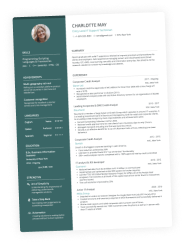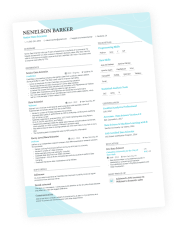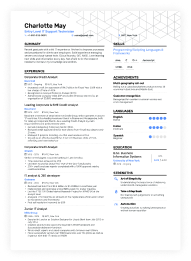Your work experience is one of the most powerful parts of your resume. It captures your career growth, hard-earned skills, and most significant contributions. But how far back should your resume go? Does that part-time job from college still belong there? Maybe not.
Figuring out how far back to go on your resume is about more than just dates. It's about relevance, clarity, and helping a hiring manager quickly understand why you’re the right fit for the job.
Let’s walk through the ideal resume length, when to make exceptions, and how to streamline your work history without losing impact.
Key takeaways
- Most resumes should cover the last 10 to 15 years.
- Choose roles that are relevant, recent, and results-driven.
- Be strategic about the length and layout of your work history.
- Only go further back if it adds clear value to your application.
- Tailor each version of your resume to the specific job you're targeting.
How far back to go on your resume: the 10 to 15 year rule
In most cases, your resume should cover the last 10 to 15 years of your career. That usually means showcasing the three to five most recent positions—the roles that best reflect your current skills and aspirations.
Why stick to this range?
- Hiring managers read fast: Resumes typically get just seven seconds of attention during an initial review. A concise work history helps your key achievements stand out.
- Older roles are often less relevant: Unless they directly relate to your target job, earlier positions may not add value.
- You protect yourself from ageism: Sharing too much history can inadvertently reveal your age and open the door to unconscious bias.
Of course, these are general guidelines—every career path is unique.
Is your resume good enough?
Drop your resume here or choose a file. PDF & DOCX only. Max 2MB file size.
Although the 10-15-year rule serves most professionals well, there are situations where extending your timeline can be advantageous.
When to go beyond 15 years
Rules have exceptions—and this one’s no different. If your career spans multiple decades or includes senior roles with long-term impact, it may make sense to go further back.
Consider extending your resume’s timeline if:
- You’re applying for C-suite or executive roles, where long-term leadership experience is a plus.
- You’re targeting academia, government, or research, where a comprehensive record is expected.
- You’ve held older roles that are still highly relevant to your desired position today.
The key is to be selective. If you choose to go back further, only do so when those earlier roles directly strengthen your candidacy.
What determines how far your resume should go back?
Deciding how far back to go on your resume depends on a few core factors:
Industry expectations
Tech, marketing, and design roles typically emphasize recent, practical skills. Meanwhile, law, education, and public sector jobs may require a more extensive background.
Career stage
If you're early or mid-career, your resume should easily fit within the 10 to 15-year range. More seasoned professionals—especially those targeting leadership roles—might benefit from highlighting select accomplishments from further back.
Job relevance
Every role you list should directly support your candidacy. Switched industries? Skip unrelated past jobs. The golden rule: If it doesn’t speak to where you’re going, leave it out.
Resume length and detail
Wondering how long a resume should be? In most cases, one to two pages is ideal. Focus on quality over quantity. Use bullet points to outline major contributions—no need for paragraphs of detail. Maintain a clean, concise, and targeted resume.
Your resume isn’t a record of everything you’ve done—it’s a marketing document for everything you’re capable of.
J.T. O'Donnell, Career Coach and Founder of 'Work It Daily'
With these elements in mind, let’s move into practical strategies for organizing an extensive career history effectively.
How to handle a long work history
If your career spans 20+ years, you’re in good company.
Here’s how to display experience without overwhelming the reader:
Focus on key roles
Select the most impactful and relevant positions to feature. These can be your most recent jobs or standout roles that closely match your target job.
Create an ‘Additional Experience’ section
Want to nod to older roles without listing every detail? Summarize them briefly under a subheading like “Other Experience,” keeping it to one or two lines per job.
Combine similar jobs
If you’ve held several roles with overlapping duties, group them together.
Sales Manager / Senior Sales Rep
Designer Furniture Corp. | Furnishing Style Ltd.
New York, NY
2000 - 2004
- Exceeded quarterly sales targets, leading to 30% client growth.
- Mentored junior staff, boosting productivity by 15%.
This strategy saves space while reinforcing your strengths.
Even when carefully condensed, your resume should subtly guard against potential age bias without sacrificing your achievements.
Resume length and age discrimination
Nearly half of U.S. professionals over 40 report experiencing ageism. One way to minimize potential bias is to limit how far back your resume goes.
If you’re concerned about age discrimination, avoid dates that reveal your graduation year or list early jobs that no longer reflect your expertise. Focus on what you’ve accomplished recently and how those achievements align with your next career goal.
PRO TIP
The Age Discrimination in Employment Act (ADEA) protects workers over 40 from workplace discrimination, including during the hiring process.
Along with managing age-related concerns, it’s equally important to thoughtfully address any gaps in your employment record.
What if you have employment gaps?
Career breaks happen—for family, health, education, or even travel.
Here’s how to handle them:
- Use a functional format to emphasize skills over dates.
- Be honest about the gap, briefly explaining the reason if relevant.
- Highlight other activities like freelancing, volunteering, or upskilling.
- Double down on skills. Certifications, online courses, or side projects all show initiative.
By approaching gaps with transparency and emphasizing skill development, you can maintain a strong and credible resume narrative.
Conclusion
Need help deciding how far back you should go on your resume? Enhancv’s Resume Builder helps you create a sharp, focused resume tailored to your goals—whether you’re climbing the ladder or pivoting to a new field.
Make one that's truly you.



